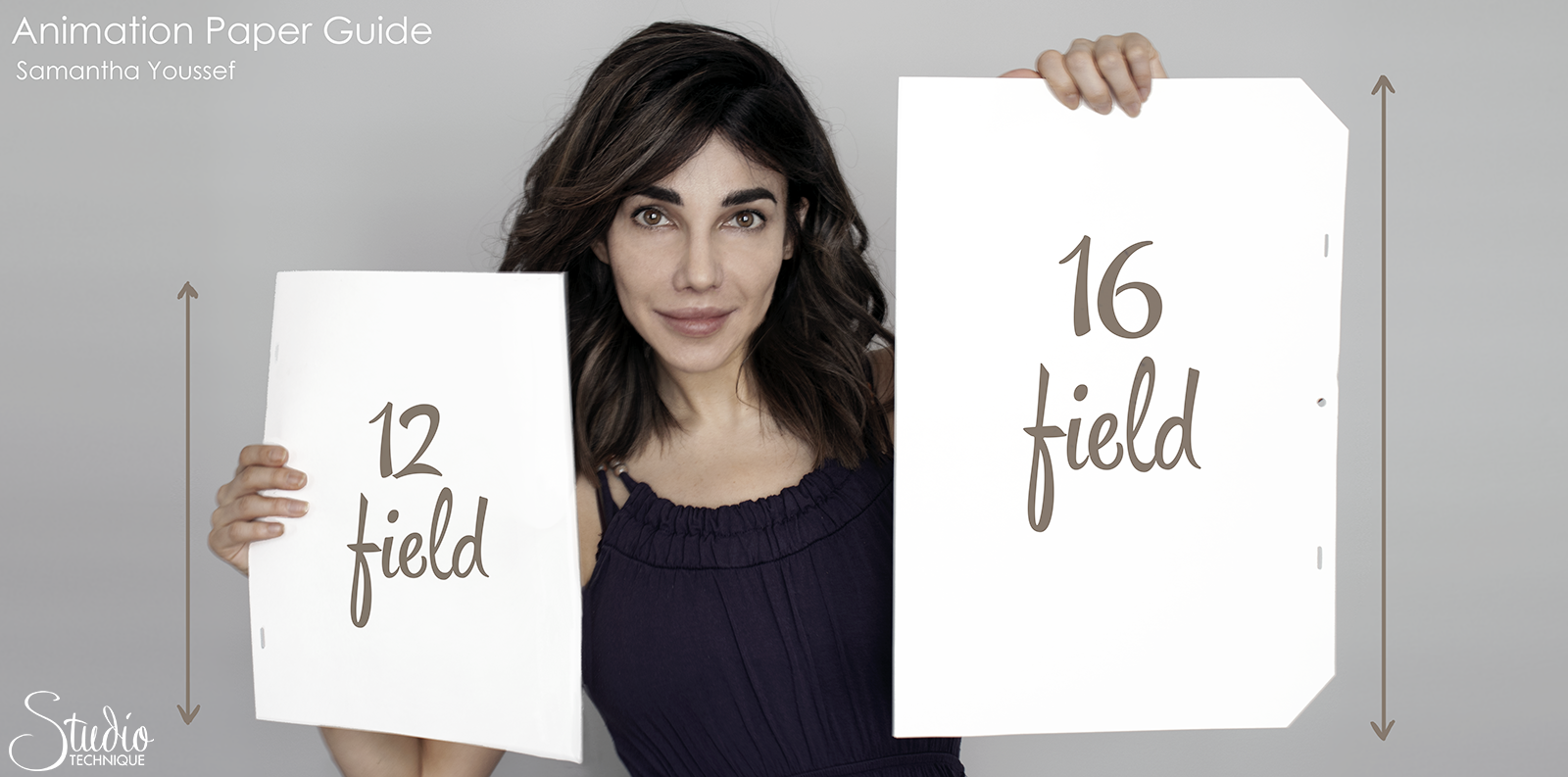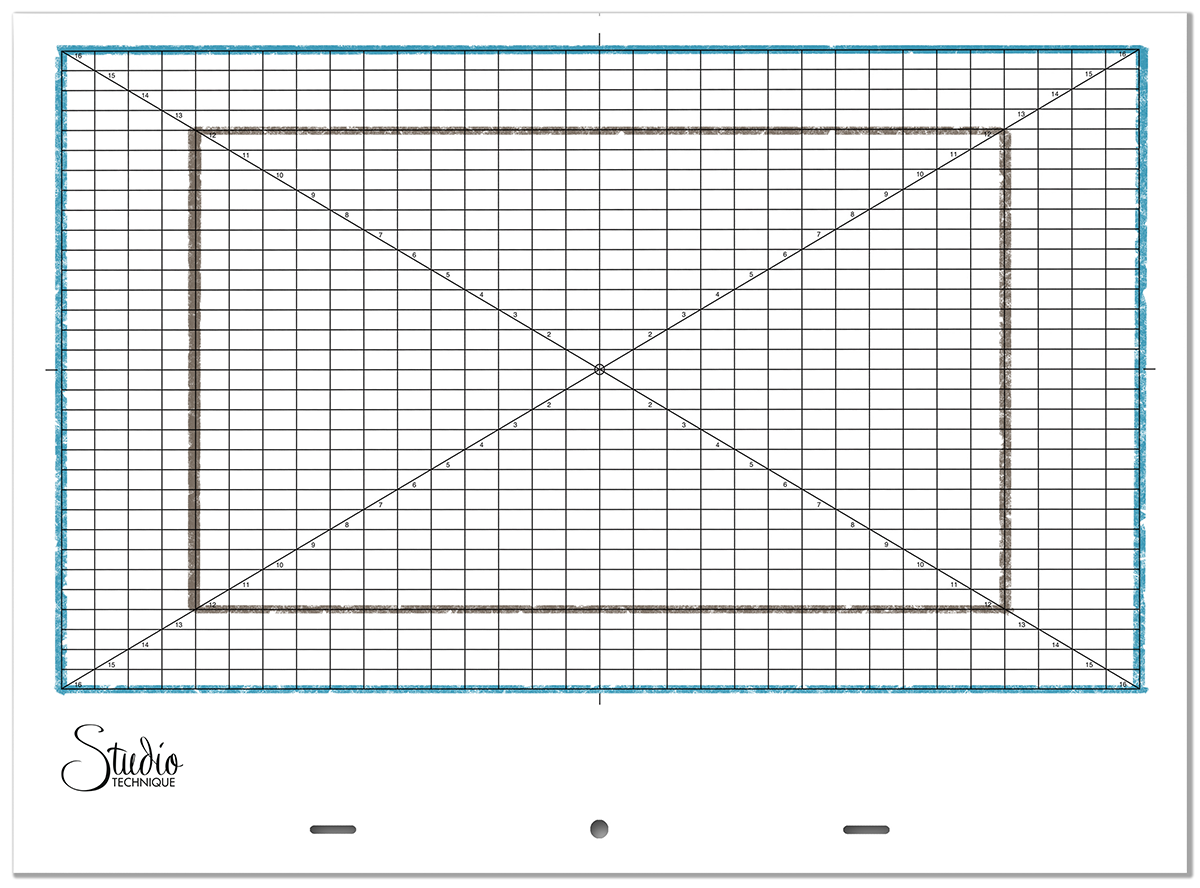Animation Paper Guide
/Let’s talk about animation paper!
While there are more and more software options available to create drawn animation, there are still certain things that can only be achieved on paper.
For the hand drawn feature quality productions with performance animation in the Disney feature animation tradition, or for the artists that are truly into the craft at the highest technical level, let’s talk a bit about paper and finding the best options for you!
Paper, as with any artistic material, can be a personal choice, and there are a few different options. I will break down some items to consider when choosing animation paper, as well as sharing what I prefer to use myself and my reasons why.
12 Field vs. 16 Field
These terms are based on camera field guides. 12 field paper (12 inch wide field guide) is obviously smaller than 16 field paper (16 inch wide field guide). Both have their advantages and challenges.
16 field vs 12 field size comparison
When you are learning, I highly recommend 12 field paper.
To start, it is significantly more affordable.
Also, when you are not as experienced an animator, 12 field helps when you are learning to flip paper. The main reason that I prefer paper over digital is because you can flip your paper as you draw. There are flipping options in software packages, but they do not translate as effectively or work as fast and concisely as with paper. For more information on flipping, check out my flipping tutorial.
Mastering this technique is far better on 12 field paper. Once comfortable, it is easier to transition to 16 field, but it’s important to learn how to do this properly. If you are aiming for the highest quality of animation, you can not rely on your backlight or onion skinning, you need to flip CONSTANTLY as you work. Flipping technique can get sloppy with 16 field paper, so it’s important you learn it properly on manageable sized paper. I still work on 12 field paper at times because the ease of flipping on it allows you to work faster.
Clip from Hand Drawn Animation documentary film
Once you are experienced, and looking to create the highest quality of feature film animation, 16 field is the better option.
If you are aiming for performance oriented animation, or more sophisticated feature film animation in the Disney tradition, you will need the canvas size that 16 field offers you. This will become obvious to you as you progress. When starting out with basic exercises, 12 field is enough. However as you progress, you may feel restricted and that you need more space to draw. 12 field will eventually become quite limited, especially when handling acting, lip sync, and complex performance.
There are also projections in the theatre to consider. If your animation is going to be screened in a theatre, like the films we made at Disney, then 16 field paper scales better than a smaller drawing surface. Think of it in the way we apply this to photo resolution. The larger the paper, the higher the resolution.
I have a stash of both sizes of paper at my studio. They each have advantages depending on what I’m working on.
12 Field:
PROS:
more affordable
better for learning to flip paper
CONS:
limited canvas size
not as suited for higher resolution, theatrical release work.
16 Field:
PROS:
better drawing canvas
better for higher resolution (theatrical) screening
CONS:
more expensive
harder to learn on for flipping
Paper Quality
There are various types of paper you can get. This can get a bit personal, and is dependent on your drawing style as well. There are a variety of paper weights available. Experience with your way of working and the materials you use will help you choose what you like best. For myself, I feel it is dependent on the kind of pencils I’m using (how dark or light they are), how much flipping is required (how much paper endurance is required), and the length of the scene I’m animating (this also effects the amount of strain on the registration punches in the paper and if they will tear and deform).
Quality animation paper is made with some translucency, so that you can see the impression of the drawing on the paper beneath the page you are working on. However this does not mean that it is flimsy. Professional animation paper is also made with the understanding that you will be doing a lot of flipping, and therefor it has to endure the physical demands that flipping places upon it, as well as any erasing and any corrections you are doing to your drawings. Pro animation paper is a specific design of paper.
Some suppliers offer a mid tier standard quality of paper. It is not made for high end professional use, but it is still reliable in most cases and good for lower end productions or student work.
Suppliers often offer a cheaper economy option as well. This paper is much more affordable but tears easily. It is similar to printer paper, however I believe it is even thinner, to offer some translucency. It is without the reinforced quality that professional paper provides. This is fine for when you are testing the waters in animation, but it will not be ideal for when you get into more sophisticated work as it gets damaged easily with flipping and erasing.
Back in the hand drawn days at Disney Feature Animation, we used Chromacolour Prograde Plus animation paper.
Chromacolour used to be a Canadian company but is now turned over in the U.K. The paper options are not exactly the same as they were before, but this would be the professional paper that is the equivalent:
https://www.chromacolour.co.uk/animationsupplies/animation-paper/pro-grade-animation-paper.html *
* There are many other suppliers that sell animation paper. You do not have to go with Chromacolour. I have always purchased through Chromacolour, so it is the only one I can suggest from my personal experience. I have heard good things about Lightfoot LTD as well. Both companies manufacture environmentally conscious paper which I appreciate as well!
Paper Texture
How much tooth or smoothness? This can depend on your drawing materials. The higher quality paper that is made specifically for animation usually has one side that is a little smoother, and another side that has a bit more tooth (rough texture) to it. Depending on the drawing materials** you use (how waxy or chalky your drawing pencils are), you may prefer the smooth side or you may prefer the toothier side. I appreciate that about quality paper, I like being able to have the option that works best with the pencils I’m using.
** Side note: choosing your drawing pencils is dependent on your approach to drawing. Let me know in the comments if this is something you’d like me to talk about in the future!
Punched vs. Unpunched
Punched animation paper is slightly more expensive as it comes already punched with standard animation pegbar registration.
If you purchase unpunched paper, you will need an animation paper punch. Proper animation paper punches can get very expensive. On top of the cost, you can only punch three to four sheets of paper at a time without damaging the punch, so it can be very time consuming to do this yourself.
Some people use a three round hole punch, like the ones you use for your school binders or office documents. While this can function, it is not a very good option for feature quality character animation. Proper animation punches alternate square and round holes. This type of peg registration provides much more secure paper alignment.
Classic 16 field disc Pegbar with alternating circle and square pegs
I personally recommend buying punched paper, and saving yourself the hours of time it would take to punch all the paper you will need. As well the cost of the punch equipment is so high, it’s only worth it if you are a production studio.
DIY Paper
Some people opt to punch their own paper with round pegs, as they can use cheap printer paper (A4) and a regular hole punch. There are now peg bars available with three round holes instead of the animation standard of square and round pegs alternating. This can be a much more affordable option and great for learning on a budget or if you just want to try animation out for fun.
The downside of this is that it can work for basic fundamental assignments, but if you want to get into more sophisticated animation, the paper quality of basic A4 paper is not resilient to the flipping you are required to do and will tear or breakdown easily. There is also size to consider. A4 paper has an even smaller drawing area than 12 field paper. As well, the reason for the square and round alternating pegs is for a more secure alignment of your pages. As the paper wears down around the holes, it becomes looser and is therefor no longer as aligned. This means that your animation can jitter if the paper is not securely aligned to the registration pegs.***
***There are reinforcement stickers that you can purchase to help with this, but they are not always necessary if you have higher quality paper.
Please let me know on my instagram post if you liked this kind of article! I’ll be happy to post more conversations like this in the future!







